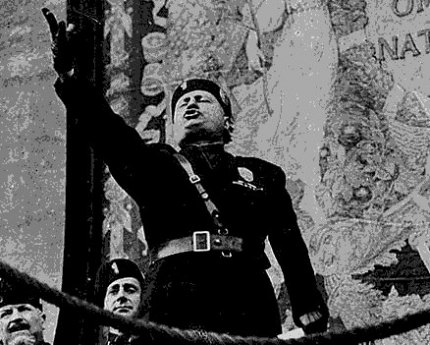Fascism: Formed in a time of turbulence

Both are evocative of another time -- 100 years ago -- marked by turbulence and even pandemic. Here is a condensed account, along with links for further study:
What is fascism? The United States Holocaust Memorial Museum identifies fascism as the "far-right political philosophy, or theory of government, that emerged in the early twentieth century. Fascism prioritizes the nation over the individual, who exists to serve the nation. While fascist movements could be found in almost every country following World War I, fascism was most successful in Italy and Germany."
Similarly, Merriam-Webster gives this definition: "a political philosophy, movement, or regime (such as that of the Fascisti) that exalts nation and often race above the individual and that stands for a centralized autocratic government headed by a dictatorial leader, severe economic and social regimentation, and forcible suppression of opposition."
There was another factor too. In 1918, the world was coming to grips with a deadly flu pandemic. A study released earlier this year found a correlation between that pandemic and the rise of Nazism. "Areas which experienced a greater relative population decline due to the spread of influenza spend less, per-capita, on their inhabitants in the following decade," reported the study by Kristian Blickle, published by the Federal Bank of New York. "This holds especially for spending on amenities more likely to be consumed by the young, for example school funding. Second, influenza deaths of 1918 are correlated with an increase in the share of votes won by right-wing extremists, such as the National Socialist Workers Party (the Nazi Party), in the crucial elections of 1932 and 1933."
The root of the word and the movement: Historians credit Benito Mussolini with the inception of modern fascism. He founded the Partito Nazionale Fascista (National Fascist Party) in Italy in 1919, the Holocaust Museum website points out.
But the word comes from a symbol of authority, according to the American Heritage Dictionary. "The Italian name of the movement fascismo is derived from fascio, 'bundle (political) group,' but also refers to the movement's emblem, the fasces, a bundle of rods bound around a projecting ax head that was carried before an ancient Roman magistrate by an attendant as a symbol of authority and power."
Commonalities among fascist movements: Fascist movements have differed from one another. But "they had many characteristics in common, including extreme militaristic nationalism, contempt for electoral democracy and political and cultural liberalism, a belief in natural social hierarchy and the rule of elites, and the desire to create a Volksgemeinschaft (German: “people’s community”), in which individual interests would be subordinated to the good of the nation," reports Encyclopaedia Britannica online.
So, what is antifa? Merriam Webster gives us a simple definition, "a person or group actively opposing fascism."Resources:
- The American Heritage Dictionary: (Houghton Mifflin Harcourt; 2016).
- Constitutional Rights Foundation: Mussolini and the Rise of Fascism.
- Encyclopaedia Britannica: Fascism, by Robert Soucy Professor Emeritus of History, Oberlin College.
- Fascism: A Warning, by Madeleine Albright, (Harper; 2018).
- Federal Reserve Bank of New York: Pandemics Change Cities -- Municipal Spending and Voter Extremism in Germany, 1918-1933, by Kristian Blickle, May-June 2020.
- Holocaust Encyclopedia, the United States Holocaust Memorial Museum: Fascism.
- Merriam-Webster online: Antifa, definition.
- Merriam-Webster online: Fascism, definition
Like us on Facebook and tell us what you think.

